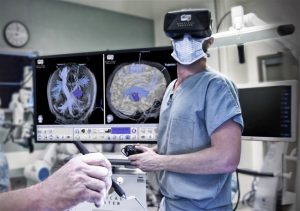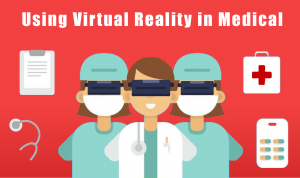What is Virtual Reality?
Virtual reality can be define by explaining both of the terms individually. ‘Virtual’ refers to near and almost to reality but not completely. So virtual reality just literally mean ‘near-reality’. Virtual reality uses human’s five senses of taste, touch, smell, sight and hearing to create a computer-generated virtual world. It creates a version of reality for the users that really isn’t there, but perceived as real.
Other than games and entertainment, there are many applications of virtual reality. One of the useful application of VR is in the field of medical.
How does VR benefit the medical industry?
The uses of VR is vast and extremely useful when doctors need a detailed visualisation of a patient’s situation before deciding. In medical, it is always a challenge for doctors to make the most logical decision in complex operations.
Precise Planning of Operations
Today, surgeons will sometimes face unique cases that will need more attention than their normal procedures. It puts them in a difficult situation to ensure their analysis and judgements are accurate. Virtual Reality can help solve the challenge by giving surgeons the power to visualize the situation with more details.
Before the surgery, doctors can take a CT, ultrasound, and MRI scan to create a highly detailed 3d virtual model of the patient’s affected part. The surgeons can then wear the VR to ‘enter’ the patient’s affected body part and identify potential risk and confidently plan to mitigate it during surgery.
Based on a previous case of successfully separating a conjoined twins, Dr. Anthony Azakie said that VR technology helped them walked through the structure of the twins in high-resolution visualization that helped them exactly see what they want. He is one of the surgeons who separated the twins and it significantly helped them minimize the surprises that can endanger the twins. Thus, VR can significantly help surgeons to get precise visualisations to determine the best action to complete the surgery at a lower risk.

A surgeon using a VR headset to enter a patient’s brain
Minimising Pain and Anxiety
Besides providing doctors’ visualisations and analysis, patients can also use VR to treat their illnesses. Despite taking pain medications, many patients will still experienced extreme pain that can be hard for them to endure. Fortunately, Virtual Reality can help solve this effectively.
Burn patients are benefitting mostly from VR since they will need to clean and bandage their burn areas daily. Especially for severe burn patients, they are actually experience one of the most painful procedures in medicine. When a burn patient is immerse into a VR game during treatment, is it found that they experience less pain by as much as 50% than patients whom do not.
Moreover, the anxiety of cancer patients who undergoes chemotherapy infusions can also be reduced with the use of VR. Especially to children, it helps them to be less distressing during the treatment procedures that are frightening.
It is also worth mentioning that VR will not replace pain medication in the future, it will be better when we combine it. With both in effects, it will be much more effective in minimizing the patient’s pain. Hence, VR is actually a useful technology in helping them to reduce their pain and anxiety more effectively.
Conclusion
Apart from these benefits of utilizing VR technology in medical field, there are many other more that we did not cover in this article. We hope that it gave you a fresh perspective on how virtual reality can improve and enhance the medical industry. If you are thinking of developing a virtual reality software, you can reach us at Gameka for assistance.





About The Author: Bernard Yap
More posts by Bernard Yap